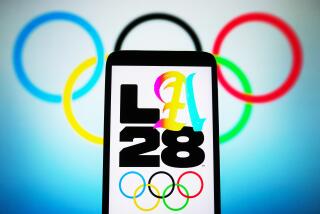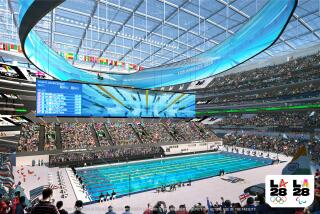They’re Gladly Going Downhill in Vail : Sports: It’s becoming clear that the United States is becoming an important player on the ski-racing circuit. And that makes people in this Colorado city very happy.
Anyway you slice it, Swiss skier Michael von Gruenigen was the Big Cheese in the World Cup giant slalom race down a precipitous 52-gate course in the Colorado Rockies over the weekend.
Like all of his teammates on the Swiss national racing team, Von Gruenigen wore a Lycra bodysuit imprinted to resemble a giant piece of Swiss cheese--holes and all.
Standing atop the victory podium in spring-like sunshine, the 26-year-old from the town of Schonried accepted the winner’s medal, a check for 20,000 Swiss francs (about $17,600) and a peck on the cheek from Vail Mayor Peggy Osterfoss.
“Have a nice day,” Von Gruenigen said, grinning shyly as he concluded a 20-second-long victory speech.
The ski-racing circuit known as the alpine World Cup had come to Vail, turning the town’s alpine-style village into a temporary center of international winter sport.
They call it “the White Circus” for the obvious reason: the snow. But the overwhelming sensation on the race course, in the viewing stands and adjacent areas was one of intense color. Ski racing is a kaleidoscope of the spectrum--on the skis, the boots, jackets, gloves, sunglasses, hats, headbands, the gates marking the race course, and the giant banner across the finish line.
The Swiss skiers really stood out, however. When you see those giant chunks of cheese hurtling down the course, there’s no mistaking the country they represent.
Others are not so obvious. The Germans wear black tiger stripes on a white background. The Americans have spider webs all over their orange, red and purple racing outfits. Nothing says U.S.A.
The Italians wear their country’s flag colors of red, white and green, but in Picasso-like swirls, not stripes. The word Italia runs down one leg, but even more prominent is FILA, one of the team’s big sponsors.
The Swedes have brilliant yellow jackets trimmed in blue--the national colors. Covering the entire back is the face of a boastful, grinning cartoon animal vaguely resembling Elsie the Cow in pain.
“It’s a gorilla,” explained one of the Swedish skiers killing time in Pepi’s Bar.
Half a block away, the new queen of international downhill racing, the United States’ irrepressible Picabo Street, autographed posters at a trendy boutique and ski shop.
*
Everywhere throughout Vail and neighboring Beaver Creek, there was the babble of different languages from the 250 best-in-the-world ski racers representing 20-plus countries. The Austrians brought more than 60 racers and coaches to Vail. Liechtenstein had two.
Along for the ride were a thousand or so others: coaches; trainers; officials of the Federation International du Ski (FIS), the winter sports governing body; ski- and boot-company service reps; the media, and race sponsors hawking everything from BULA headbands to Rolex watches and Chevy trucks.
Several thousand residents watched the races from the temporary grandstands, many of them clanging little cowbells handed out by race sponsors.
The White Circus is only an occasional visitor to North America. Through the heart of the ski season each year, World Cup ski racing makes the circuit of the storied resorts of the Alps: Val d’Isere, Cortina, St. Moritz, St. Anton, Kitzbuhel and others.
Aspen and Vail have been somewhat regular appendages to the circuit in November and early December because snow conditions tend to be more reliable than in the Alps. Until this year, Aspen hosted one of the premier events, a men’s downhill race, each March.
But the alpine countries overwhelmingly dominate the World Cup circuit. They have the best skiers, the biggest crowds, the richest sponsors and a vast television audience of race fans.
Skiers like the flamboyant Alberto Tomba of Italy and Marc Giradelli of Luxemboug are national heroes. So are just-retired Vreni Schneider of Switzerland, and Katja Seizinger and Martina Ertl of Germany.
“Everywhere you go in Europe, every weekend, it’s like another Mardi Gras,” said Doug Sack, a ski-race writer from Whistler, British Columbia, who has covered more than 100 cup races. “It’s a weeklong party that ends with the races on the weekend.”
With these races coming so early in the season, Vail lacked the crowds and holiday atmosphere that dominate the European events. There weren’t even any stories about Tomba going out on the town. That is expected to change with late-season major skiing events scheduled in Vail the next four years.
In the United States, there is a hard-core following of fans who study the World Cup standings in Ski Racing International, a weekly published in Vermont. Most Americans get excited about international ski racing every fourth year--with the Olympics. Once the Olympic flame goes out, ski racing fades to a blip on the American TV screen, somewhere behind bowling and yachting.
But there was solid evidence at Vail last week that the United States is becoming a more permanent and important link in the circuit. This season’s opening consists of an unprecedented eight races in Vail, in neighboring Beaver Creek and in Park City, Utah, this weekend. After Utah, the men return to Vail on Dec. 1-2 for a men’s downhill, considered the most popular of all international racing events.
Vail expanded its sponsorship this year after Aspen gave up its March downhill race. World Cup insiders said Aspen wanted to free itself of the obligation of putting much of its area off-limits to paying recreational skiers in the lucrative heart of the ski season.
“Vail puts a ton of money into these races,” said a circuit veteran. “The big payoff is exposure in Europe. That’s the best place to expand their tourist market.”
Osterfoss, Vail’s mayor, said the races are good for Vail from the standpoint of community cohesion and enthusiasm. But, she added, “In terms of international awareness, participation in the World Cup has been very significant to us in increasing our tourism.”
*
Other factors are making the United States a more important player in international ski racing. Most notable was the success of American racers last season after their impressive medal harvest at the 1994 Olympics.
Street and Hilary Lindh won eight of the nine women’s downhill races during the 1994-95 season--a feat that shocked Europeans. Street became the first American, male or female, to win a season’s World Cup trophy in downhill.
Kyle Rasmussen won two men’s downhill races, including the prestigious Lauberhorn race at Wengen, Switzerland, last year. The men’s team now boasts three proven winners who can challenge Europe’s best downhillers on an equal footing any race weekend: Rasmussen, AJ Kitt, and Tommy Moe, downhill winner in the 1994 Olympics.
Also, U.S. Ski Team management, based in Park City, is putting its house in order after suffering several years of fund-raising problems, budget cuts, staff layoffs and coaching turnover. The ski team has a new general sponsor, Chevy Trucks, that promises to promote the U.S. team more vigorously and get its skiers on television more frequently.
There is a new overall World Cup sponsor as well, Cafe de Columbia, a marketing association of coffee growers and shippers. Cafe de Columbia has expressed keener interest in the U.S. market than the previous sponsor, Sergio Tacchini, a European clothing manufacturer.
Vail has bid successfully to be the site of the 1999 World Alpine Championships, the most important event other than the Olympic Games. And Vail also will host the 1997 World Cup Finals--the last races of the season in which both men and women compete in all the race disciplines.
About those team uniforms. . . . Longtime race-tour observers said the German team adopted the tiger-stripe uniform some years back, when the team’s uniform sponsor, Borgner, was promoting a line of clothing with a jungle motif.
And the spider webs on the U.S. uniforms? The suits are provided by a team sponsor, Spyder, the outdoor clothing manufacturer.
More to Read
Go beyond the scoreboard
Get the latest on L.A.'s teams in the daily Sports Report newsletter.
You may occasionally receive promotional content from the Los Angeles Times.





